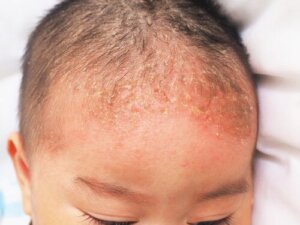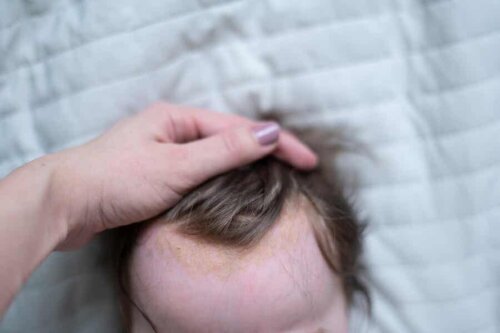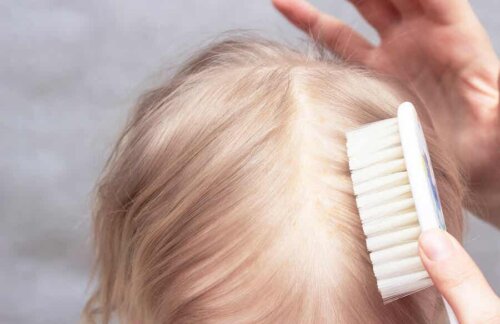What's Seborrheic Dermatitis in Infants?


Written and verified by the dermatologist Maria del Carmen Hernandez
In general, new parents are concerned when they notice seborrheic dermatitis in their infants. Also known as “cradle cap,” it consists of reddened, scaly areas of skin on the scalp.
This isn’t usually serious but there are some things to keep in mind. Let’s see what they are below.
How does seborrheic dermatitis manifest in infants?
It may occur in small areas, form tight clusters, or cover the entire scalp. The affected areas may have some of the following:
- Thick scales or crusts on the scalp, but also on ears, eyelashes, eyebrows, nose, groin, neck, or armpits although this isn’t common
- Oily or greasy skin areas, often covered with scales
- White or yellowish, sticky scales that remain adherent to the skin
In infants with sensitive skin, dry skin, or eczema, seborrheic dermatitis may lead to cracked itchy skin, with subsequent secretion of translucent fluid. Patches of dermatitis vary from infant to infant.
Rarely, infants with seborrheic dermatitis have a slight reddening of the skin that may or may not be itchy. Some also lose hair but it grows back after the condition goes away.

What causes cradle cap?
The causes of seborrheic dermatitis in infants aren’t exactly known. Specialists believe it may be due to excess sebum production by the skin’s sebaceous glands. Furthermore, it may be stimulated by hormonal changes in the mother during pregnancy.
Another theory suggests the existence of a fungus called Malassezia, which has the ability to grow along with bacteria in the sebum of the skin. It could be another cause of this condition.
Read about the Symptoms of Seborrheic Dermatitis and Treatment
Prognosis of seborrheic dermatitis in infants
Cradle cap is neither an infection nor contagious, and not usually serious. It isn’t an allergy caused by contact with something, nor is it caused by poor hygiene; it usually starts in the first few weeks of life. Moreover, it disappears slowly over a period of weeks or months, without leaving marks or scars.
It may suddenly reappear at a later date after this period but the following indications can help keep the condition under control.
A doctor must make a correct differential diagnosis to rule out other illnesses with similar clinical pictures, such as:
- Psoriasis
- Fungal dermatitis
- Atopic dermatitis
- Some primary immunodeficiencies
- Langerhans cell histiocytosis

Seek medical attention if …
In general, it’s easy to identify seborrheic dermatitis with the naked eye. However, consult a pediatrician in the following cases:
- It’s the first time you seek treatment for a dermatitis
- It causes excessive itching or hair loss
- Also, it’s located in hairless areas of the body
- The condition worsens or spreads to other areas
- The baby has an altered immune system
- There’s evidence of infection such as oozing and the patch is hard, hot, or red
- The infant has difficulty gaining weight
You may be interested in The Link Between Dermatitis and Corticosteroids
Treatment
Most cases don’t require treatment but it’s often necessary to remove the scales from the scalp and eliminate them. Take the following steps in such cases:
- Rinse the hair frequently with a mild pH hypoallergenic and fragrance-free baby shampoo. Don’t use those that are medicated and stronger – considered to be anti-seborrheic – because they can be irritating.
- Gently massage the scalp with a cotton pad using almond oil or petroleum jelly; avoid using olive oil. This is usually good as it softens the scales and allows them to peel off the scalp.
- Rinse well afterward because any remaining oil may stimulate the formation of scabs.
- Use 100% cotton clothing and wash it with neutral soap.
Consult a doctor for inflammatory, persistent or extensive cases. They should be able to prescribe a specific shampoo or lotion to help in the treatment of skin dryness and scaling. Note that the stronger forms of these formulations require a prescription.
Seborrheic dermatitis in infants isn’t a cause for concern
This condition is common in babies and usually resolves on its own. Most people treat it due to aesthetic concerns.
Finally, consult a pediatrician before applying any type of product, especially if it spreads to other areas or shows signs of infection.
All cited sources were thoroughly reviewed by our team to ensure their quality, reliability, currency, and validity. The bibliography of this article was considered reliable and of academic or scientific accuracy.
- Castillo, E. (2014). Dermatitis seborreica: una revisión. Dermatologia medica, cosmética y quirúrgica, 12(2), 135-41.
- Fortuño, J. Dermatitis seborreica del lactante.
- Marín, G. M. G., Díaz, Y. G., & Pérez, L. R. (2020). Dermatitis seborreica infantil extensa en un lactante. Revista de Ciencias Médicas de Pinar del Río, 24(3), 4355.
This text is provided for informational purposes only and does not replace consultation with a professional. If in doubt, consult your specialist.








